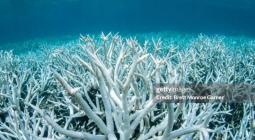An underwater experiment to restore coral reefs using a combination of “coral IVF” and recordings of fish noises could offer a “beacon of hope” to scientists who fear the fragile ecosystem is on the brink of collapse.
The experiment – a global collaboration between two teams of scientists who developed their innovative coral-saving techniques independently – has the potential to significantly increase the likelihood that coral will repopulate degraded reefs, they claim.
The first use of the combined techniques, to repair damaged atolls in the Maldives, will be shown on the BBC One TV series Our Changing Planet, co-presented by the naturalist Steve Backshall.Hailed as a potential “gamechanger”, the hope is that the technique could be replicated on a large scale to help preserve and revitalise dying reefs.
“All corals in all ocean basins in the world are under pressure,” said Prof Peter Harrison, a coral ecologist at Southern Cross University in Australia.
“Quite a large number have died in some reef areas. So we’re going to end up with big spaces of new real estate for coral larvae, but very few coral larvae being produced because so many adults have died.”
He has pioneered a form of “coral IVF” that involves capturing millions of spawn from “heat-tolerant” reproductive coral after it floats to the sea surface or, alternatively, surrounding coral that has withstood a bleaching event with a cone-shaped net. The net functions like a huge “coral condom”.
“If you breed from heat-tolerant corals that can survive heat stress in the laboratory, the larvae of those corals also have higher heat tolerance than the larvae of other corals,” said Harrison.
The gametes (reproductive cells) then merge together, fertilise and form coral larvae in floating “nursery” pools, which protect them from predators and prevent them from getting lost at sea. “If we don’t support the process of natural selection by focusing on the survivors, we’re going to lose everything.”
This technique, Harrison added, can produce 100 times more coral colonies than would naturally occur on a reef with the same number of larvae: “And we’re working out ways to get it to about 1,000.”
To attract the larvae to settle on a degraded reef, the scientists are broadcasting recordings of fish noises that were captured near a busy, healthy reef. “We’ve done this and restocked degraded reefs with fish,” said Steve Simpson, professor of marine biology and global change at the University of Bristol.
“Working with Peter is the first time we’ve tried it with corals. It maximises the chance that the coral larvae being released find somewhere to live – somewhere that they will then restore the reef habitat.”
Coral larvae, he has discovered, can detect sound according to the way the hairs on their bodies move, and so can be “tricked” into swimming towards – and settling on – a typically silent, unhealthy reef. “It’s like sowing a field that will become a forest again,” said Simpson.
In the lab, the larvae were particularly attracted to the low-frequency grunts, croaks and rumbling sounds made by territorial fish, which can protect coral growing on the reef. “We have discovered that coral larvae hear their way home as babies, before they then choose where to live for up to 1,000 years,” Simpson said.

“They look very simple, and they don’t have ears or a brain, but coral were probably among the earliest animals cueing into their soundscape and dancing to the beat.”
Time is running out for coral reefs across the planet.Scientists recently announced that the world is experiencing its fourth planet-wide coral bleaching event since 1998, with 54% of reef areas in the global oceans experiencing heat stress high enough to turn its colourful coral white. Australia’s Great Barrier Reef has suffered its worst bleaching on record, with about 73% of the 1,429-mile (2,300km) reef affected.
Backshall initially found the idea of using the soundscape of a busy reef to entice the tiny coral larvae to a denuded area “just bananas”.
“To see that happening – to take these gametes into the sea, play them the sounds of a healthy reef and see them actively start swimming towards it – it is probably as close to a eureka moment as I will ever have,” he said.
He fears, however, that if global temperatures rise by 2.5C or 3C, then “coral reefs are doomed”, regardless of these new techniques: “If we continue business as normal in terms of anthropogenic climate change, I don’t think it’s going to matter what we do.
“Tropical reefs are right on the frontline. But if we can keep our levels of temperature increase across the planet down to 1.5C, then there’s a chance – and then these methods will absolutely be part of a positive future.”
The world is “very gradually” waking up to the enormity of the global climate emergency, Harrison said. In the meantime, he and Simpson are “just trying to buy time for corals”.
“If we can keep enough reefs alive through the next two or three bumpy decades to be able to recover, we’ve then got the reefs for the future, once the climate is under control,” Simpson said.
“People say that coral reefs might be the first ecosystem we could lose, and I like to think that, therefore, they are the first ecosystem we can save. If they’re on the brink, and we can save coral reefs, we can save anything. And they become a beacon of hope.”





